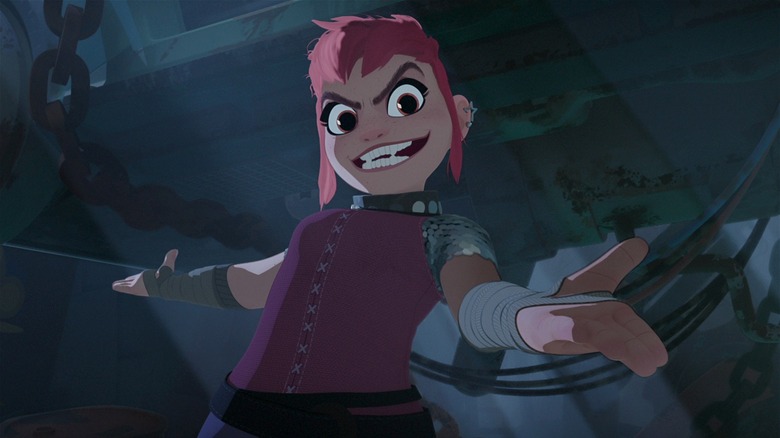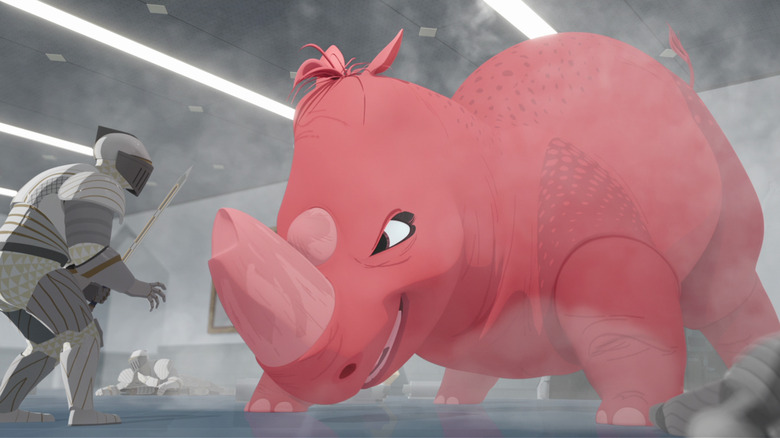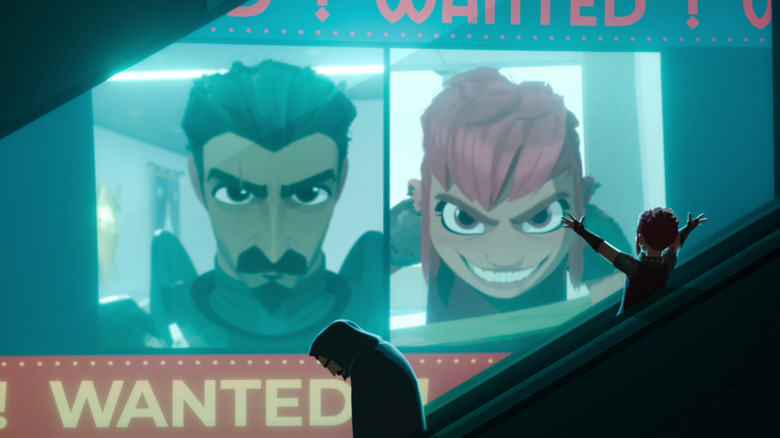Nimona Review: Canceled, Rescued, And Ready To Get Metal
- The main character is awesome
- Fun sense of style
- Allegories are meaningful despite their obviousness
- Not as innovative or exceptional as it could have been
"Nimona" is a movie that almost didn't get released. Originally in production at 20th Century Fox's Blue Sky Studios, this animated adaptation of ND Stevenson's comic was delayed following Fox's purchase by Disney, and was around 75% complete when Disney ultimately shut Blue Sky down in 2021. The official reason given for the studio's closure was the economic impact of the COVID-19 pandemic, but Disney leadership reportedly also had issues with "Nimona" — specifically, its LGBTQ+ content, which includes a major gay romance and a protagonist who rejects gender labels altogether. Just when it seemed the film was lost, Netflix and Annapurna Pictures revived the production. The work already done on the film at Blue Sky was preserved, though it changed directors from Patrick Osborne to Nick Bruno and Troy Quane.
We can all be glad "Nimona" is finally seeing the light of day. It arrives on Netflix at the end of a stressful Pride Month, so its central allegory about the demonization of queerness and otherness could not be more necessary. Like its title character (voiced by Chloë Grace Moretz), the film is fun and chaotic, but with a lot of heart that reveals itself over time. While it's not the greatest of animated films — anything coming out this year is gonna have a hard time comparing to "Spider-Man: Across the Spider-Verse" – it will connect deeply with the young viewers who need it most, and entertain and move older watchers.
If Shrek was queerer and cooler
If you need an easy demonstration of the effect that aesthetic and tone can have on a movie, consider this: In concept, "Nimona" is an awful lot like "Shrek," yet in execution, it's completely different. Both films take place in worlds inspired by fairy tales and medieval fantasy, but with anachronistic contemporary twists that aim to subvert those older tropes. Their title characters — monsters who only behave as such because the world at large has judged them to be monstrous — are also strikingly similar in concept.
Of course, "Shrek" is also dominated by a Los Angeles vibe, top 40 pop hits, and nonstop comedy. "Nimona," in contrast, is New York-ish, punk/metal/indie rock, and a mix of action-adventure with sci-fi intrigue. When people say an animated movie is "Shrek"-like, they typically don't mean it's a commentary on fairy tales and the nature of monstrousness — they mean it makes constant pop culture references for the parents and PG-rated bodily function gags. While "Nimona" is funny in ways that sometimes involve pop culture references and bodily functions, there's much less emphasis on either element than in a lot of American animated movies. It's cool in a way most kids' films aren't.
"Nimona" is also visually distinctive, though not as dramatically as it would have been had it come out three years ago, as originally intended. The rest of the animation industry is finally experimenting with new styles and adding 2D textures to 3D animation, which means "Nimona" arrives not as a leader in a movement, but as a welcome participant. It isn't quite on the "Spider-Verse" level of astonishment, but its colorfully graphic style is hugely appealing. Nimona must have been a particularly fun character to animate, between her dramatic extremes of acting and her many violently adorable shapeshifting forms. One criticism of the animation must be made, however: While the shading creates a stylized-yet-nuanced look for the main characters, nondescript background figures end up looking almost low-resolution. Perhaps this is a result of production difficulties in switching studios, or simply time and budget limitations — but hey, at least the stuff that matters looks great.
A balance of light and dark
As an adaptation, "Nimona" preserves the attitude of the original work, but keeps plot specifics loose. It kind of goes without saying that the comic's epidemic storyline wouldn't fly today. Ballister Boldheart (Riz Ahmed) is also no longer a self-described supervillain, but instead, a former knight turned reluctant enemy of the state after being framed for the murder of Queen Valerin (Lorraine Toussaint). As such, Nimona isn't pushing a refined villain into chaos — she's pushing a would-be hero to embrace villainy, the same way she has embraced being seen as a monster.
This question of monsterdom gives the movie its greatest heft as a queer narrative, even more than Ballister's love for champion knight Ambrosius Goldenloin (Eugene Lee Yang), the non-binary implications of Nimona's shapeshifting, or the casting of RuPaul, Indya Moore, and Julio Torres in supporting roles. It's not the least bit subtle with its allegories of how government and religious faith are used to persecute individuals who fall outside societal norms, but obviousness can be forgiven when presenting weighty themes to younger audiences. Plus, the themes themselves hold enough truth that they connect with older viewers as well.
Certain aspects of the story have been significantly lightened up — the flashbacks to Nimona's past are decidedly less horrific, for starters — but different forms of emotional darkness have been brought to the fore. The final act goes to a particularly intense place. The fact that "Nimona" pulls this off, yet also features a dancing shark, is hugely impressive. "Nimona" isn't a masterpiece of animation, but it's better and more memorable than a lot of recent Disney releases. Their loss, Netflix's gain.
"Nimona" streams on Netflix starting June 30.


